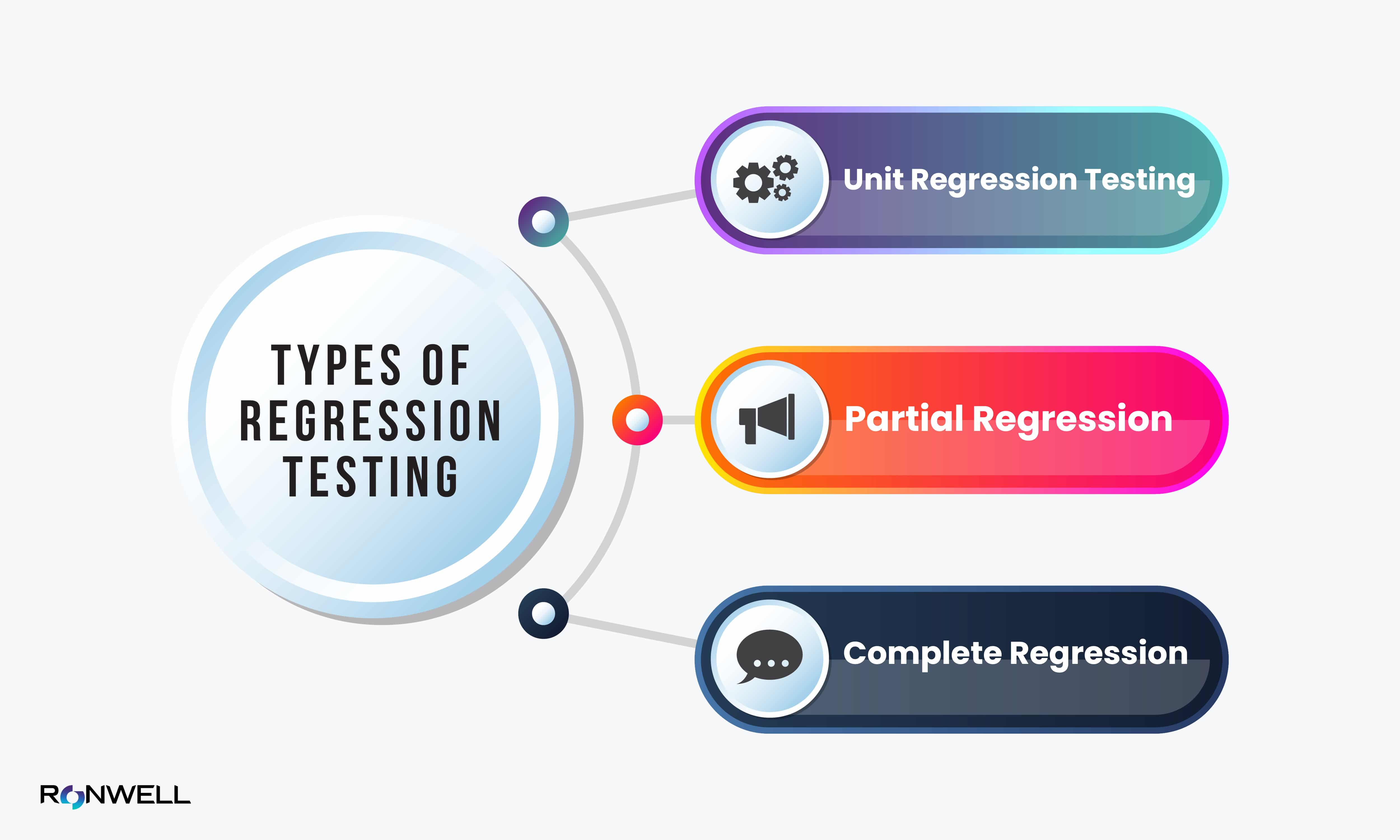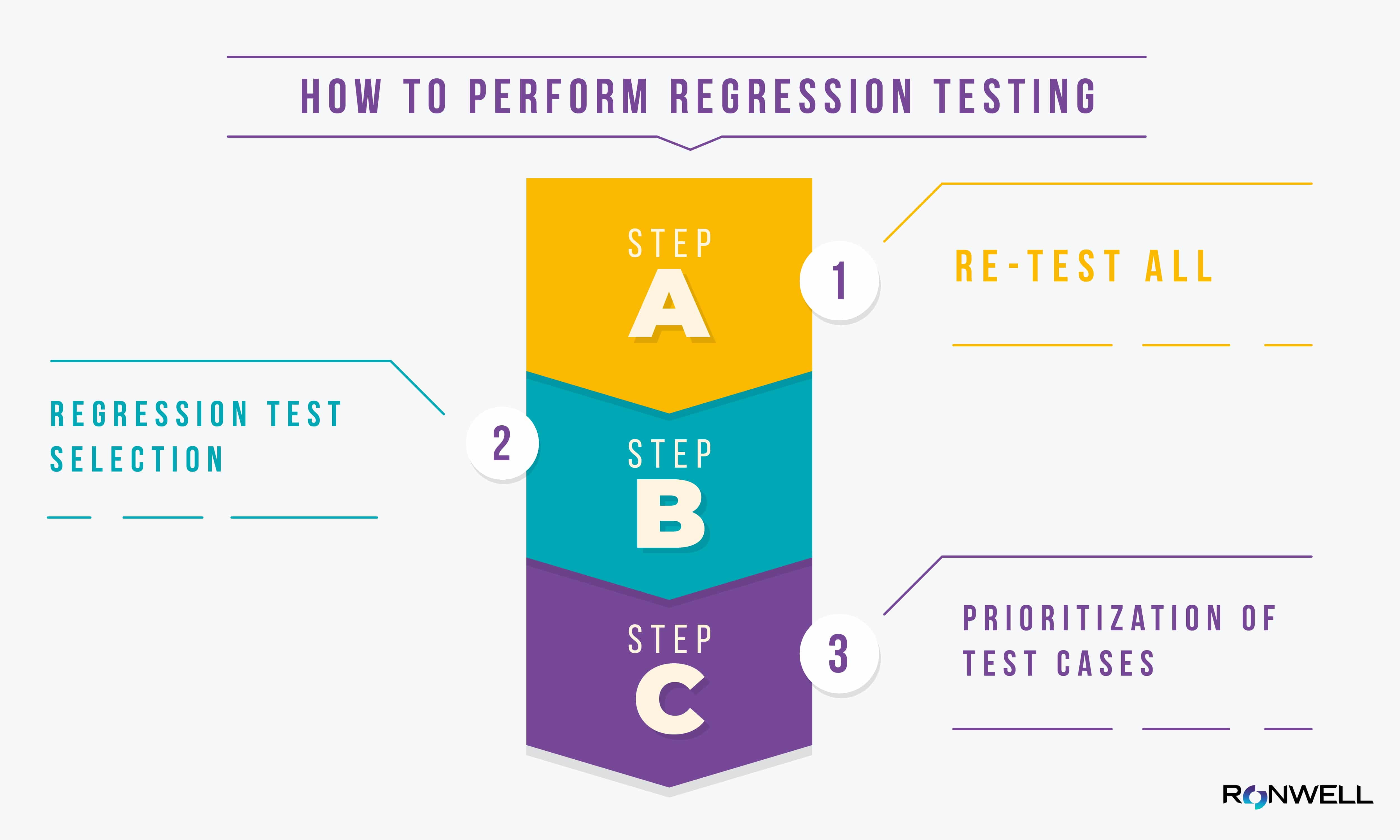

Our Services
Test Automation ServicesAI & Machine LearningBlockchainCRM ConsultingData Science & EngineeringDevOpsDigital MarketingDigital TransformationEmbedded Software DevelopmentERP Consulting ServicesManaged IT ServicesMergers & Acquisitions AdvisoryQA And Testing ServicesRobotic Process Automation SAP Consulting DevelopmentSoftware and Application DevelopmentSQL ConsultingStrategy ConsultingSustainability
- Contact Us
Our Services
- Test Automation Services
- AI & Machine Learning
- Blockchain
- CRM Consulting
- Data Science & Engineering
- DevOps
- Digital Marketing
- Digital Transformation
- Embedded Software Development
- ERP Consulting Services
- Managed IT Services
- Mergers & Acquisitions Advisory
- QA And Testing Services
- Robotic Process Automation
- SAP Consulting Development
- Software and Application Development
- SQL Consulting
- Strategy Consulting
- Sustainability
Insight
Company
Industries
- Contact Us

What is Regression Testing? Definition, Tools, Example and More
Discover the meaning, types, and importance of regression testing in software development. Learn effective methods to streamline your testing process.
- insight
- /
- blog
- /
- regression-testing
In the fast-paced and ever-evolving world of software development, ensuring that applications perform flawlessly is essential for success.
This is where regression testing comes into play, serving as a critical process to validate the functionality and stability of software after changes or upgrades.
In this article, we will explore the concept of regression testing, objective of regression testing, various types of software testing, importance of regression testing, regression testing advantages and disadvantages, effective regression testing methods, regression testing example, regression testing in software engineering, and recommended regression testing tools to streamline the process.
So, whether you are a developer, QA engineer, or simply interested in learning more about software testing, join us as we cover everything about regression test strategy and its significance in delivering high-quality software.
What Is Regression Testing?
Regression Testing is performed after any code change to ensure that the product's functionality has not been compromised.
That way, you know the product won't break when you add features, fix bugs, or make other adjustments to it. Previously performed test cases are re-executed in order to validate the effect of the modification.
Let’s look at the regression testing meaning. Regression Testing is a type of software testing in which previously executed test cases are run again to ensure that the application still performs as expected after changes have been made.
So, how to do regression testing? Regression testing should be performed on a new build when the original feature has changed significantly, even if it's just because of a bug fix.
Regression testing in software testing refers to running tests on code that have not been modified.
Why Is Regression Testing Important?
Regression testing is important in software development by verifying the stability and reliability of software systems.
The importance of regression testing cannot be overstated. It is a crucial process that involves retesting known bugs after each code change. By adopting an iterative approach and frequently pushing new code, developers aim for agility, even if it means breaking things temporarily.
However, regression testing acts as a safeguard to prevent the reintroduction of bugs and ensures that previously functional aspects of the software remain intact. This process becomes particularly significant in maintaining the integrity of the system when there is a continuous stream of code changes.
Let's explore regression testing example to understand the importance of regression testing.
Imagine you're a software development company working on a project to create an application for image and video editing. After developing the initial build with the necessary features, you conduct regression testing using 1000 test cases to ensure the app functions correctly. Once the app passes the regression test, you share it with the client for feedback.
The customer is pleased with the initial version, yet desires additional components. So, you develop and integrate those features into the existing app. However, since new code has been added, you must perform regression testing again. To do this, you create 100 new test cases to verify the functionality of the app. Additionally, you need to re-run the 1000 previous test cases to ensure that essential functions have not been affected.
This is a typical scenario for regression testing. While it's advantageous to verify every small code change against the core features of the product, it can also be challenging.
Nevertheless, being aware of this fact allows you to prepare for regression testing in advance. In the following discussion, we will outline the ideal situations in which regression testing is performed.
Types of Regression Testing
Here are the different types of Regression Testing.
Unit Regression Testing (URT)
Unit Regression is performed during the Unit Testing phase, where the code is tested in isolation. Dependencies on other units are blocked to ensure that the unit being tested can be evaluated individually without any interference.
Read Also: Unit Testing vs Functional Testing Comparison
Partial Regression
Partial Regression is conducted to validate the functionality of the code when changes have been made. It ensures that the modified unit works properly and integrates smoothly with the existing code that remains unchanged.
Complete Regression
Complete Regression is carried out when changes are made to multiple modules or when the impact of a change on other modules is uncertain. The entire product is thoroughly tested to identify any changes or regressions resulting from the modified code.

Software Regression Testing Techniques
Here are the regression testing steps.
- Re-test All: This software regression testing technique involves re-executing the entire test suite to ensure that all test cases pass after modifications are made.
- Regression Test Selection: Instead of executing the entire test suite, a selected subset of test cases is chosen based on factors such as high-risk areas or impacted functionalities.
- Prioritization of Test Cases: Test cases are prioritized based on factors like business impact, criticality, and frequently used functionalities. Higher-priority test cases are executed first during regression testing.
- Test Case Optimization: This software regression testing technique focuses on optimizing the existing test cases by removing redundant or duplicate test cases to streamline the regression testing process.
- Test Case Impact Analysis: This technique involves analyzing the impact of changes made to the software and identifying the affected areas to prioritize regression testing efforts.
- Configuration Management: Managing the configuration of software and test environments ensures that regression testing is conducted consistently across different environments and configurations.
For more information about Configuration Testing
- Test Automation: Automating regression testing using tools and scripts helps improve efficiency and speed up the testing process. Automated regression testing tools can execute a large number of test cases accurately and repeatedly. To learn more about automated testing tools, read our article.
- Continuous Regression Testing: Introducing regression testing as a part of continuous integration and continuous delivery practices ensures that any changes to the software are immediately tested for regressions.
- Risk-Based Regression Testing: This technique involves assessing and prioritizing the risks associated with software changes to determine the extent and focus of regression testing efforts.
- Agile Regression Testing: Integrating regression testing into the Agile development process allows for iterative testing of new features and changes to prevent regressions from impacting the product. In other words, Agile Regression Testing helps development teams focus on adding new features while keeping the product stable as new features are added.
- Exploratory Regression Testing: This technique involves exploring the software and conducting ad-hoc testing to identify any unexpected regressions or issues caused by changes.
- Maintenance Regression Testing: When maintaining legacy systems, this technique involves regularly conducting regression testing to ensure that modifications or fixes do not introduce new defects.
- Hybrid Testing: Regression Test Selection and Test case Prioritization are brought together to form the hybrid approach. Instead of rerunning every test in the suite, you may pick and choose which ones are most important to you.
You might like: Smoke Testing vs Regression Testing: Which One to Use and When?
Regression Testing in Agile
Regression testing in agile process is an integral part of the iterative and incremental development approach. In Agile, the product is developed in short iterations known as sprints, typically lasting 2-4 weeks. As new functionalities or code changes are introduced in each sprint, regression testing in agile process plays a crucial role in ensuring the overall stability and quality of the software.
To effectively perform regression testing in Agile, it is important to have a regression test suite prepared from the initial phase of the project. This test suite should be continuously updated with each sprint to accommodate the changes and additions made to the software.
Regression testing in agile process are typically categorized into two types:
- Sprint Level Regression: This type of regression testing focuses on the new functionalities or enhancements introduced in the latest sprint. Test cases from the test suite are selected based on the specific additions or changes made in the sprint.
- End-to-End Regression: End-to-End Regression involves the re-execution of all test cases to thoroughly test the complete product, covering all core functionalities. This ensures that the integrated system functions as intended and that the changes made in one area do not negatively impact other areas of the product.
Due to the short sprint cycles in Agile, it is highly recommended to automate the regression test suite. Test automation reduces the time required for execution and helps prevent defects from slipping through the testing process. Automation enables faster and more efficient regression testing within the limited timeframe of each sprint.
See Also: Test Automation Strategy: Importance, Benefits & Example
When Can We Perform Regression Testing?
We can perform regression testing whenever modifications are made to the production code. regression testing should be performed in the following scenarios:
- When new functionality is added to the application. For instance, if a website introduces a feature to allow users to log in using Facebook in addition to email.
- When there is a change in requirements. If the ability to save login information is taken away from the sign-in page, which had previously been an option.
- When defects or bugs are fixed. For instance, if the login button on a login page was not functioning properly and it was reported as a bug. After the developers fix the issue, regression testing is conducted to ensure that the login button is working correctly, along with other related functionalities.
- When performance issues are addressed. For example, if the loading time of a home page was reduced from 5 seconds to 2 seconds.
- When there are environment changes. This can occur when there is a switch from one database system, such as MySQL, to another, such as Oracle.
In these scenarios, regression testing is performed to ensure that the modified code and changes have not introduced any new issues and that the application functions as intended.
How to Perform Regression Testing of Software
Regression testing is required when modifying existing software to make improvements, fix bugs, optimize performance, or remove features. These modifications have the potential to impact the functionality of the system, making regression testing essential in such cases.
To perform regression testing, the following regression testing methods can be done:
- Re-test All: In this regression testing method, all test cases are re-executed. When a test case fails and the cause of the failure is identified as a software fault, the fault is reported and a new version of the software is expected with the defect fixed. Re-testing is then conducted to confirm that the fault has indeed been resolved. This approach, however, can be time-consuming and resource-intensive.
- Regression Test Selection: In this regression testing methods, a selected subset of test cases is executed instead of the entire test suite. The selected test cases can be categorized as reusable or obsolete. Reusable test cases can be used in subsequent regression cycles, while obsolete test cases are no longer relevant for future regression testing.
- Prioritization of Test Cases: Test cases are prioritized based on their business impact, criticality, and frequency of functionality usage. By selecting and executing prioritized test cases, the regression test suite can be reduced while still ensuring that crucial aspects of the software are thoroughly tested.
These regression testing methods help ensure that software modifications do not introduce new defects or negatively impact the system's overall functionality.

Top 5 Regression Testing Tools
With applications getting smarter and more complicated, every company wants to give its target audience a smooth user experience. Because of this, regression testing tools are becoming more popular and are being used by more and more businesses.
A study from Global Market Insights (GMI) in August 2022 says that the software testing market was worth $40 billion in 2021 and is expected to grow at a compound annual growth rate (CAGR) of 6% between 2022 and 2030.
Regression testing can be made easier, better, and more automated with the help of testing tools. Here are the top 5 regression testing tools:
Selenium
Of course, Selenium is the first and the top regression testing tool.
It is a widely recognized and popular regression testing tool for browser-based and cross-platform testing. It offers automated test scripts and is particularly suitable for large-scale quality assurance testing with experienced testers.
Katalon Studio
Katalon Studio provides a comprehensive regression automation testing solution, suitable for web services, web apps, and mobile app testing. It is an important tool for regression testing in automation.
It aims to simplify and make the testing process more accessible, even for novice testers.
The regression testing tool also offers reporting and advanced analytics capabilities.
Watir
Watir is an open-source regression testing tool written in Ruby. It allows testers to write test cases that are easy to read and understand.
Watir's lightweight and flexible user interface makes it a preferred choice, and it offers interactive capabilities for website testing.
IBM Rational Functional Tester (RFT)
RFT is an automation tool developed by IBM, supporting various types of testing, including regression, functional testing, and data-driven testing.
It simplifies the testing process for testers worldwide and can be used for testing different applications such as web apps, .NET, Java, SAP, and emulator-based apps.
Apache JMeter
Apache JMeter is an open-source regression test automation software primarily used for performance testing.
It is written in Java and provides features such as load and performance testing, measuring service performance, and offering a regression testing suite for end users.
Best Practices / Advantages for Regression Testing
Here are the best practices and advantages for regression testing:
- Keep Up With the Latest Regression Suite: Stay updated with the latest regression testing suites by considering functional and non-functional requirements. Execute high-priority and high-value test cases first to ensure thorough testing.
- Know Every Change Hands-on: Stay informed about modifications by establishing regular communication between developers and testers. This helps testers plan their testing in advance and stay on track with app or product releases.
- Assign Grades to Test Cases: Evaluate the business impact of test cases on different platforms and assign high, medium, and low priorities. This helps prioritize testing efforts and identify roadblocks effectively.
- Understand the Scope of Testing: Before starting regression testing, understand the scope of the testing project in terms of goals, time, and objectives. This allows for better planning and execution of the regression cycle.
- Automate the Right Test Cases: Identify test cases that can be automated and those that are not suitable for automation. Automating appropriate test cases increases productivity and saves time.
- Track Return on Investment (RoI): Evaluate the effectiveness of your regression testing activities by following the Return on Investment (RoI) through advanced analytics and reports generated by automation programs. This helps identify areas that need improvement and provides insights into the effectiveness of the testing efforts.
Here we have listed some advantages of Regression Testing:
- Regression testing helps identify defects or issues introduced by software changes, ensuring the stability and reliability of the application.
- It ensures that existing features and functionalities of the software are not affected by new changes.
- By detecting issues early, regression testing saves costs associated with fixing bugs in later stages of development or during production.
- Regression testing ensures a smooth user experience by validating that all functionalities work as intended.
- Thorough regression testing builds confidence in the software by providing assurance that changes do not break existing functionality.
- It helps maintain compliance with industry standards and security requirements by validating the impact of changes on these aspects.
- By incorporating regression testing into the development process, teams can learn from past issues and continuously improve the quality of their software.
Challenges / Disadvantages in Regression Testing
Regression testing advantages and disadvantages can be summarized as follows:
- High Cost: Regression testing can be time-consuming when done manually. Therefore, automation is preferred, but it requires expensive infrastructure and tools, leading to high upfront costs. Check out our blog article: Manual Testing vs. Automation Testing.
- Enormous Scope and Coverage: The effectiveness of regression testing relies on the test case suite that has been developed. With every build and release, the regression suite needs to be updated. It can be challenging for testers to remember each change and ensure comprehensive coverage, making the scope of regression testing enormous.
- Testing Approach: The selection of an appropriate testing approach is crucial for successful regression testing. Having skilled resources and tools is not enough if there is no proper plan in place for when and how to conduct regression testing.
- Complexity: As the software progresses from one build to another, the number of test cases increases, leading to a more complex regression test suite. Testers need to test both new and old cases consistently, adding to the complexity of regression testing.
These challenges highlight the need for proper planning, automation, and effective management of the regression test suite to overcome the complexities and ensure the success of regression testing.
The Future of Regression Testing
The future of regression testing is expected to evolve with advancements in technology and software development practices. Some key trends that will shape its future.
For instance, increased Automation is the future of regression testing. It will become more automated with the use of advanced testing tools and frameworks. Automation will help speed up the testing process, reduce human errors, and improve overall test coverage. For further information, read Test Automation Framework: Benefits, Types & How to Choose.
There will be a greater emphasis on incorporating regression testing earlier in the software development lifecycle. By catching issues and defects earlier, teams can address them promptly and minimize their impact on the overall system.
Artificial intelligence and machine learning technologies will play a significant role in regression testing. These technologies can help in test case generation, test data management, and intelligent defect prediction, improving the efficiency and effectiveness of regression testing.
With the increasing adoption of cloud computing, regression testing will leverage cloud-based testing platforms. This will provide scalability, flexibility, and cost-efficiency in running large-scale regression tests across different environments and configurations.
As organizations embrace DevOps practices, regression testing will become an integral part of continuous testing pipelines. The focus will be on automating regression tests, integrating them with continuous integration/continuous delivery (CI/CD) pipelines, and ensuring quick feedback on code changes.
Final Thoughts on Regression Testing
Regression testing remains a crucial aspect of software development and maintenance. It ensures that modifications and enhancements do not introduce unintended issues or regressions into the existing functionality.
While it has its challenges, such as the need for careful test case management and potentially time-consuming execution, regression testing offers significant benefits in terms of maintaining software quality and stability.
To navigate the complexities of regression testing and maximize its effectiveness, partnering with a reliable software testing and quality assurance provider is essential.
Ronwell Digital, a trusted leader in the industry, offers comprehensive regression testing services tailored to your specific needs. Our team of experienced professionals uses the latest regression testing tools and methodologies to streamline the regression testing process and deliver accurate and timely results.
Don't compromise on the quality and reliability of your software. Contact Ronwell Digital today to ensure seamless regression testing and drive the success of your software projects.
FAQs
What are regression tests in QA?
Regression tests in QA refer to a set of tests that are conducted to ensure that changes or modifications in software do not negatively impact existing functionality. These tests are performed after code changes, bug fixes, or system updates to verify that the previously developed and tested features continue to work as expected.
Regression testing helps in identifying and addressing any unintended side effects or regressions that may have occurred due to the changes made, ensuring the overall stability and reliability of the software.
Why is it called regression testing?
Regression testing is called so because it aims to "regress" or verify that previously developed and tested functionalities have not been adversely affected or "regressed" by any new changes or modifications in the software.
Is regression testing good?
Yes, regression testing is good and important in software development and QA. It helps ensure that changes or modifications in software do not introduce unintended issues or regressions into the existing functionality. By retesting previously developed features, regression testing helps identify and address any potential problems or conflicts caused by new code, bug fixes, or system updates.
Is regression testing UI testing?
No, regression testing is not UI testing. While UI testing is a part of regression testing, regression testing encompasses a broader scope.
You Might Like:
- What Does QA Stand For Software
- What is Automation Testing? Types, Examples, Process
- 5 Failures in Test Automation: Best Practices for Dealing with Them
- How to Create Test Cases for Automated Tests? With Example
References
Browser Stack - Regression Testing
Writer:

Halime Yılmaz
Content Marketing Specialist
13 min read
8 June 2023, Thursday
Related Posts
Related Industries
Related Services











